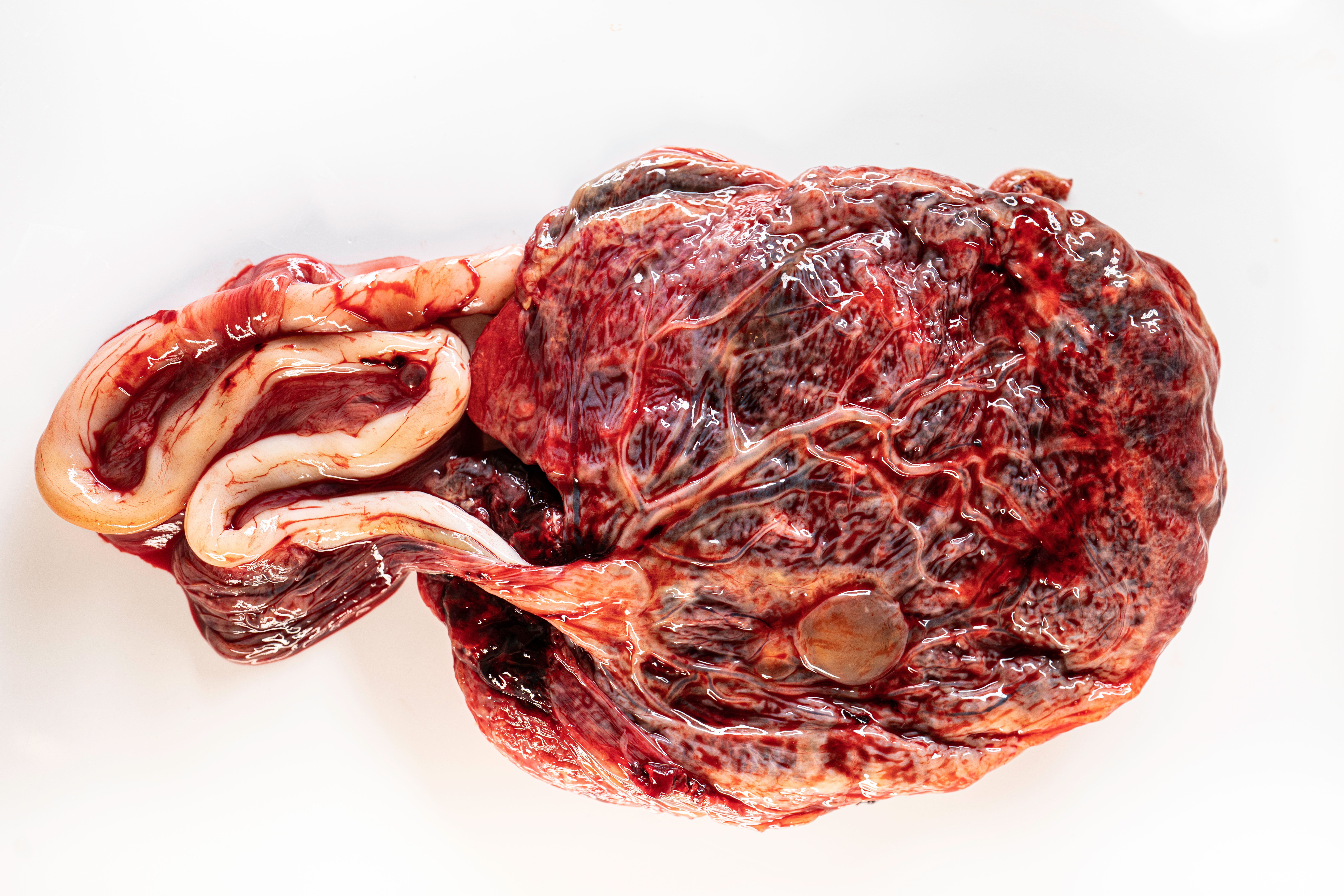If you think of birth as a story, there is an obvious climax: the delivery of the baby! All of the lead up of laboring through difficult contractions and pushing culminates in the birth of a screaming newborn into the world. While movies and TV make it seem as if this is the end of the story, those depictions aren’t quite accurate. Though the delivery of the baby is what every mother most looks forward to, she isn’t really done until she finishes the third stage of labor, which is birthing the organ that her body helped create to nourish her child while in utero—AKA, the placenta.
While birthing the placenta is typically a much less arduous process than birthing a brand new human, it is not without its challenges and risks. A major risk in the third stage of labor is postpartum hemorrhage (PPH), or excessive bleeding after birth. In response to this potential issue, many doctors and midwives choose to manage the birth of the placenta in a more active way in an attempt to avoid PPH. But is a more active management of placenta delivery necessary or evidence-based compared to an expectant or wait-and-see approach? Here, we’ll explore the data on these various approaches to the third stage of labor.
What are the stages of labor?
First, let’s review all three stages of labor.
Act I
The first stage of labor is both the longest and has two parts: early labor and active labor. Early labor is the very beginning of the laboring process. This is when the cervix begins to dilate and soften, with more mild contractions that may be inconsistent. Many women choose to spend their early labor period at home, as it can last for hours or even days, especially for first time moms.
Active labor starts once the cervix is dilated past 6 cm, and contractions are now stronger, closer together, and coming more regularly. This is typically when most healthcare professionals will tell women to go to the hospital or birthing center if they’re not delivering at home, and this may also be when your water breaks. Active labor typically lasts 4 to 8 hours.
Act II
You’ve officially moved into the second stage of labor once the main event begins: the birth of your baby! Pushing a baby out can be an extremely fast process or one that takes more time, depending on your position, the position of your baby, and if you’ve given birth before.
Act III
After your baby has been safely delivered, you’ll move into the third stage of labor, which is the delivery of the placenta. Your doctor or midwife will be keeping an eye out for more small contractions which signal that your placenta is detaching from your uterus and is ready to be delivered. They may also use either physical or medical interventions which can aid in the delivery of the placenta, and there are varying opinions about what level of management is necessary to ensure a healthy and safe third stage of labor. These three approaches are called expectant, active, and mixed management.
Expectant, active, and mixed management of the third stage of labor
What exactly are these three approaches to the third stage of labor, and what does each of them look like in practice? Here’s a rundown.
Expectant management
This approach is best described as a “hands off” approach, waiting for the placenta to be naturally delivered. If your doctor or midwife uses this approach, he or she will wait until you begin having post-birth contractions that will lead the placenta to naturally detach from the uterus. Then he or she will either coach you to push it out, or let it deliver on its own using gravity. There are no interventions provided, and the umbilical cord will also not be clamped or cut until either the placenta has been delivered or the cord is no longer pulsating.
Active management
This is a more “hands on” method, where your provider will use interventions to try and aid in the birth of the placenta to avoid a severe loss of blood after birth (which, again, is called postpartum hemorrhage (PPH)). The main intervention used is the injection (either intramuscularly or via an IV) of Pitocin, which is the synthetic form of the hormone oxytocin. This drug helps the uterus contract more quickly after birth and helps reduce the incidence of severe, but not moderate, PPH (more on this below).
Active management also traditionally includes physical interventions like pulling on the umbilical cord or applying manual pressure to the woman’s abdomen over the uterus, as well as clamping the umbilical cord early and before it has stopped pulsating. However, modern active management doesn’t typically involve early cord clamping, as most organizations (including ACOG, the American College of Obstetrics and Gynecology) recommend delayed cord clamping.
Mixed management
In practice, mixed management is what many hospital-based doctors or midwives in the United States gravitate towards, as the traditional definition of active management includes early cord clamping. This might look like giving Pitocin but allowing the placenta to be birthed without any manual aid, and typically does not include early cord clamping as that has largely fallen out of practice. It’s important to note that many of the studies done on this subject are actually talking about mixed management when they say “active management,” as traditional active management includes all three prongs of Pitocin, early cord clamping, and cord pulling or traction.
Historical approach to the third stage of labor
The main reason providers started to implement certain interventions such as Pitocin and pulling on the umbilical cord is that the focus for the third stage of labor has largely shifted to trying to prevent PPH. Historically, it was more common to allow the birth of the placenta to happen naturally and then treat PPH if it happened, using methods like vaginal packing or giving the laboring woman a “labor tea” which was made out of a fungus called ergot that caused uterine contractions [1]. These steps were a response to increased bleeding, not preventative measures.
In the early 1900s, a physician named Dr. Barry Hart in the UK began giving ergot before PPH began as a way to prevent too much bleeding, which was the first example of a more active management of the third stage of labor. This gradually transformed into giving Pitocin as a preventative measure after its discovery in the 1950s, as ergot is known to have serious side effects for some women. As time went on, more doctors felt it necessary to give Pitocin during the delivery of the placenta to help the uterus contract more quickly and decrease the chances of hemorrhage.
What is the most evidence-based approach to birthing the placenta?
This is a complicated question that lacks a one-size-fits-all answer. The decision to use active or expectant management largely comes down to how high your risk for PPH is, as preventing hemorrhage is the main reason that providers practice active or mixed management (as opposed to expectant).
It depends on your personal risk factors for PPH
Studies show that the women at the highest risk for PPH are those who are above the age of 35, have a history of preterm birth, have a cesarean section, or give birth to either a larger baby (over 8 lbs 13 oz) or a baby who experiences difficulty breathing after birth (neonatal asphyxia) [2]. Women with placenta previa, a retained placenta (parts of the placenta remaining in the uterus after birth), abnormal uterine anatomy from fibroids, or those who experience uterine rupture can also be at a higher risk for PPH.
In low-risk women, the benefits of active management are less clear
For those who are not at high risk for hemorrhage, most of the evidence points to tenuous (minimal) benefits of using active management. A 2019 Cochrane review found that low-risk women did not see any meaningful difference in severe PPH (blood loss greater than 1000 mL, equivalent to half a 2 Liter soft drink bottle) or the need for their babies to be sent to the NICU with active management compared to without [3]. Even when they looked at the data from all women (including those who were at a higher risk), researchers still found that it was uncertain whether or not active management reduces the risk of severe PPH, which is a blood loss of over 1000 mL.
However, the researchers did note that active management probably reduces the rate of blood loss greater than 500 mL, and may also reduce the need for maternal blood transfusion.
Conflicting studies
Conversely, another study from 2013, which used data from over 32,000 low-risk pregnant women receiving midwifery care in New Zealand, found that those who received active management (around half of the group) actually had 276% higher rates of PPH above 500 mL compared to women who had expectant management only, perhaps due to the manual pulling on the cord [4]. It’s important to note that these study results are observational, meaning that they come from observing the outcomes of births as they occur, and are not a part of a randomized trial with all variables controlled for. For context,
The bottom line on Pitocin and active management of the third stage of labor
Taken in tandem, all of this data seems to point to uncertain benefits for active management but no clear red flags against its use, either. If you’re at higher risk for PPH, it might be more important to consider active management to prevent excessive bleeding after giving birth.
Those who are at lower risk might have fewer benefits to receiving active management, and might want to weigh the risks of using Pitocin after birth (such as its association with postpartum anxiety and depression) more heavily [5]. Either way, it’s a great idea to talk to your doctor or midwife about management of the third stage of labor before you’re giving birth. Though it might be easy to forget about everything that happens after your precious baby is born, birth isn’t quite over once they place your newborn in your arms!








Very enlightening, especially for a male.
My 3rd stage was grossly mis-managed with the birth of my 2nd child. Thanks for sharing, this is an important topic.